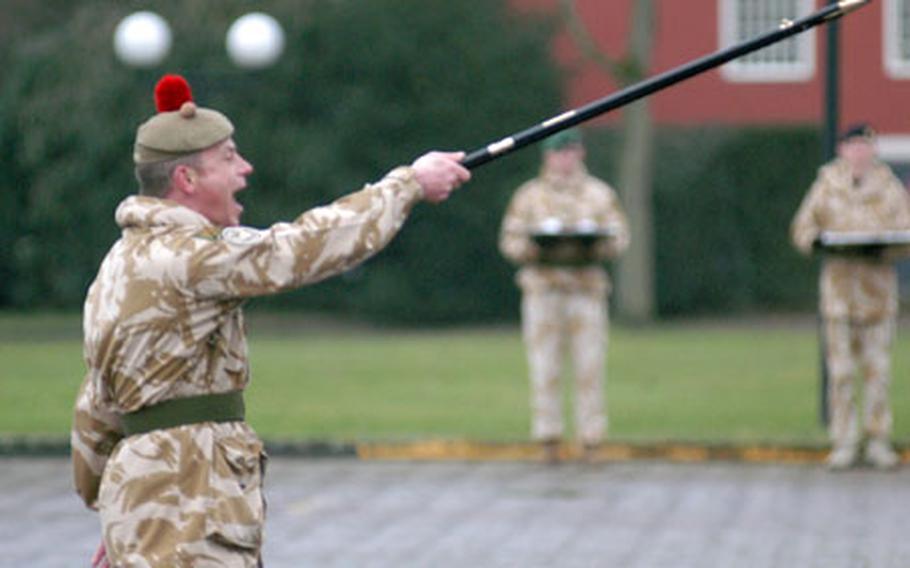
Scottish Warrant Officer 1st Class Lorne Campbell, sergeant major of NATO’s Allied Rapid Reaction Corps, shouts orders to soldiers assembled for a medal ceremony at a homecoming event for the unit. The unit, which led the International Security Assistance Force in Afghanistan, recently returned to Rheindahlen, Germany, after its nine-month tour. (Kevin Dougherty / Stars and Stripes)
RHEINDAHLEN, Germany — The new commander of the International Security Assistance Force in Afghanistan, U.S. Army Gen. Dan McNeil, is expected to take a harder line toward militants than his predecessor.
But at the end of the day, according to ISAF soldiers returning from the front, success in Afghanistan will depend more on striking the right balance.
“I believe in some cases NATO is a little reluctant to use a big stick, and I think in some cases the U.S. has been a little too quick to resort to it. So I believe that you have the opportunity for synergy there,” said U.S. Army Lt. Col. Steven Eden, who served as a liaison between ISAF and U.S. forces.
There are roughly 26,000 U.S. troops in Afghanistan. About 14,000 of them now come under the NATO-led ISAF coalition, which, up until a couple of weeks ago, was led by British army Gen. David J. Richards.
“Of course,” Eden continued, “you also have the opportunity for a little bit of discord. But my experience was that the U.S. chain of command up there and the NATO chain of command are not going to have very many difficulties. At the worker-bee level, everything was pretty smooth.”
While ISAF came under some criticism last fall during Operation Medusa, Richards, as well as a couple of U.S. officers who were in theater, said the campaign was a success. The operation, which occurred west of Kandahar, the former Taliban stronghold, included U.S., Afghan, Dutch, British and Canadian forces.
“It was very intense, conventional fighting,” Eden said. “I mean we were getting reports of breaching obstacles. The Canadians brought in their Leopard tanks right after that because they realized this was not snipers in a tree. These were dug-in people that had to be taken out at the point of a bayonet. I think that [performance] opened a lot of eyes.”
A couple of ISAF soldiers, who asked that their names not be used, said a bias does exist in the American ranks against some of their NATO partners. But every soldier brings value to the fight, even if his kit is somewhat lagging.
Despite the critics, Richards said his band of soldiers from 37 different nations “took NATO into a new era,” while scoring a tactical victory over Taliban forces outside of Kandahar and continuing reconstruction efforts.
Richards said the successor force in Afghanistan needs to get a grasp on the cultural and domestic political situation to succeed.
“In a normal war, it’s all black and white: bad guy, good guy, drop the bomb, et cetera, et cetera,” Richards said. “That is not the case in a country like Afghanistan, and I’m sure Iraq. You have got to reach out to people who may be your enemy today but can be your friend tomorrow. And I’ve learned that, and that’s an enduring lesson of history.”